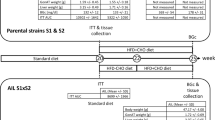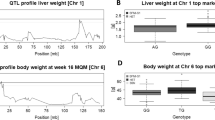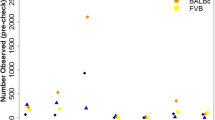Abstract
BACKGROUND: Congenic mouse strains contain donor mouse strain DNA in genomes otherwise identical to a background strain. They can be used to identify defined chromosomal regions containing obesity genes with small effects.
OBJECTIVE: The objective of this study was to discover congenic strains containing genes that influence body fat in mice and to examine interactions between these genes.
DESIGN: A survey of congenic strains showed that the B6.C-Tyrc H1b Hbbd/By (B6.C-H1) congenic strain, with a 24 centiMorgan (cM) donor region from strain BALB/cBy on chromosome 7, had 50% less fat than background C57BL/6By (B6By) mice. The congenic donor region was then divided into 11 smaller overlapping subcongenic regions. Genotype effects on obesity traits in the subcongenics were determined by breeding heterozygotes for each line and comparing phenotypes of littermates with different donor genotypes.
RESULTS: At least three subcongenic strains, two with overlapping donor regions and one with a nonoverlapping donor strain region, were found to exhibit significant influences of donor region genotype on obesity. A cross of the two overlapping subcongenics demonstrated that a single gene in the overlap region could not account for the observed obesity effects. We also observed significant obesity differences between genetically identical progeny that were contingent on the genotype of their subcongenic mothers.
CONCLUSIONS: These results demonstrate the existence of at least three genes influencing obesity in three subcongenic strains with donor strain chromosomal regions whose size ranges from 0.5 to 5 cM. A maternal effect gene influencing obesity may be present in some subcongenic strains.
This is a preview of subscription content, access via your institution
Access options
Subscribe to this journal
Receive 12 print issues and online access
$259.00 per year
only $21.58 per issue
Buy this article
- Purchase on Springer Link
- Instant access to full article PDF
Prices may be subject to local taxes which are calculated during checkout




Similar content being viewed by others
References
Aitman TJ, Glazier AM, Wallace CA, Cooper LD, Norsworthy PJ, Wahid FN, Al-Majali KM, Trembling PM, Mann CJ, Shoulders CC, Graf D, St Lezin E, Kurtz TW, Kren V, Pravenec M, Ibrahimi A, Abumrad NA, Stanton LW, Scott J . Identification of Cd36 (Fat) as an insulin-resistance gene causing defective fatty acid and glucose metabolism in hypertensive rats. Nat Genet 1999; 21: 76–83.
Bailey DW . Genetics of histocompatibility in mice. I. New loci and congenic lines. Immunogenetics 1975; 2: 249–256.
Graff RJ, Hildemann WH, Snell GD . Histocompatibility genes of mice. VI. Allografts in mice congenic at various non-H-2 histocompatibility loci. Transplantation 1966; 4: 425–437.
Snell GD . Methods for the study of histocompatibility genes. J Genet 1948. 87–99.
Snell GD, Bunker HP . Histocompatibility genes of mice. V. Five new histocompatibility loci identified by congenic resistant lines on a C57BL/10 background. Transplantation 1965. 234–252.
Taylor BA, Wnek C, Schroeder D, Phillips SJ . Multiple obesity QTLs identified in an intercross between the NZO (New Zealand obese) and the SM (small) mouse strains. Mamm Genome 2001; 12: 95–103.
Taylor BA, Phillips SJ . Detection of obesity QTLs on mouse chromosomes 1 and 7 by selective DNA pooling. Genomics 1996; 34: 389–398.
Warden CH, Fisler JS, Shoemaker SM, Wen PZ, Svenson KL, Pace MJ, Lusis AJ . Identification of four chromosomal loci determining obesity in a multifactorial mouse model. J Clin Invest 1995; 95: 1545–1552.
York B, Truett AA, Monteiro MP, Barry SJ, Warden CH, Naggert JK, Maddatu TP, West DB . Gene–environment interaction: a significant diet-dependent obesity locus demonstrated in a congenic segment on mouse chromosome 7. Mamm Genome 1999; 10: 457–462.
Podolin PL, Denny P, Lord CJ, Hill NJ, Todd JA, Peterson LB, Wicker LS, Lyons PA . Congenic mapping of the insulin-dependent diabetes (Idd) gene, Idd10, localizes two genes mediating the Idd10 effect and eliminates the candidate Fcgr1. J Immunol 1997; 159: 1835–1843.
Legare ME, Bartlett II FS, Frankel WN . A major effect QTL determined by multiple genes in epileptic EL mice. Genome Res 2000; 10: 42–48.
Bailey D . Genetics of histocompatibility in mice. I. New loci and congenic lines. Immunogenetics 1975; 2: 249–256.
Dietrich WF, Miller J, Steen R, Merchant MA, Damron-Boles D, Husain Z, Dredge R, Daly MJ, Ingalls KA, Evans CA, DeAngelis MM, Kruglyak L, Goodman N, Copeland NG, Jenkins NA, Hawkins TL, Stein L, Page DC, Lander ES . A comprehensive genetic map of the mouse genome. Nature 1996; 380: 149–152.
Copeland NG, Jenkins NA, Gilbert DJ, Eppig JT, Maltais LJ, Miller JC, Dietrich WF, Weaver A, Lincoln SE, Steen RG, Stein LD, Nadeau JH, Eric S, Lander ES . Genome maps IV 1993. Wall chart. Science 1993; 262: 67–82.
Manly KF, Olson JM . Overview of QTL mapping software and introduction to map manager QT. Mamm Genome 1999; 10: 327–334.
Knott SA, Haley CS . Maximum likelihood mapping of quantitative trait loci using full-sib families. Genetics 1992; 132: 1211–1222.
Zeng ZB . Theoretical basis for separation of multiple linked gene effects in mapping quantitative trait loci. Proc Natl Acad Sci USA 1993; 90: 10972–10976.
Zeng ZB . Precision mapping of quantitative trait loci. Genetics 1994; 136: 1457–1468.
Lander ES, Lincoln SE . The appropriate threshold for declaring linkage when allowing sex-specific recombination rates. Am J Hum Genet 1988; 43: 396–400.
Kruglyak L, Lander ES . Complete multipoint sib-pair analysis of qualitative and quantitative traits. Am J Hum Genet 1995; 57: 439–454.
Kruglyak L, Lander ES . A nonparametric approach for mapping quantitative trait loci. Genetics 1995; 139: 1421–1428.
Blake JA, Richardson JE, Bult CJ, Kadin JA, Eppig JT . The Mouse Genome Database (MGD): the model organism database for the laboratory mouse. Nucleic Acids Res 2002; 30: 113–115.
Chagnon YC, Rankinen T, Snyder EE, Weisnagel SJ, Perusse L, Bouchard C . The human obesity gene map: the 2002 update. Obes Res 2003; 11: 313–367.
Wolf JB, Vaughn TT, Pletscher LS, Cheverud JM . Contribution of maternal effect QTL to genetic architecture of early growth in mice. Heredity 2002; 89: 300–310.
Bolivar VJ, Cook MN, Flaherty L . Mapping of quantitative trait loci with knockout/congenic strains. Genome Res 2001; 11: 1549–1552.
Iakoubova OA, Olsson CL, Dains KM, Ross DA, Andalibi A, Lau K, Choi J, Kalcheva I, Cunanan M, Louie J, Nimon V, Machrus M, Bentley LG, Beauheim C, Silvey S, Cavalcoli J, Lusis AJ, West DB . Genome-tagged mice (GTM): two sets of genome-wide congenic strains. Genomics 2001; 74: 89–104.
Fijneman RJ, de Vries SS, Jansen RC, Demant P . Complex interactions of new quantitative trait loci, Sluc1, Sluc2, Sluc3, and Sluc4, that influence the susceptibility to lung cancer in the mouse. Nat Genet 1996; 14: 465–467.
Ripoche MA, Kress C, Poirier F, Dandolo L . Deletion of the H19 transcription unit reveals the existence of a putative imprinting control element. Genes Dev 1997; 11: 1596–1604.
Threadgill DW, Hunter KW, Williams RW . Genetic dissection of complex and quantitative traits: from fantasy to reality via a community effort. Mamm Genome 2002; 13: 175–178.
Acknowledgements
We thank Sue Bennett, Noreene Shibata, Sally Chiu and Daniel Petroni for their help in mouse colony management and phenotyping. This research was supported by NIH NIDDK RO1 DK52581 and PHS DK07355. Both Adam Diament and Craig Warden contributed to study design, data analysis and writing. Adam Diament was solely responsible for data collection. Neither author has any financial or personal interest in any company or organization sponsoring the research.
Author information
Authors and Affiliations
Corresponding author
Additional information
Disclaimers: None.
Supported by NIH DK52581, DK07355 and the UC Davis Clinical Nutrition Research Unit, DK35747.
Rights and permissions
About this article
Cite this article
Diament, A., Warden, C. Multiple linked mouse chromosome 7 loci influence body fat mass. Int J Obes 28, 199–210 (2004). https://doi.org/10.1038/sj.ijo.0802516
Received:
Revised:
Accepted:
Published:
Issue Date:
DOI: https://doi.org/10.1038/sj.ijo.0802516
Keywords
This article is cited by
-
Subcongenic analysis of a quantitative trait locus affecting body weight and glucose metabolism in zinc transporter 7 (znt7)-knockout mice
BMC Genetics (2019)
-
Linking cellular zinc status to body weight and fat mass: mapping quantitative trait loci in Znt7 knockout mice
Mammalian Genome (2014)
-
Subcongenic analysis of tabw2obesity QTL on mouse chromosome 6
BMC Genetics (2012)
-
A wild derived quantitative trait locus on mouse chromosome 2 prevents obesity
BMC Genetics (2010)
-
Serious limitations of the QTL/Microarray approach for QTL gene discovery
BMC Biology (2010)



